for Facial Injuries
24 Norfolk Street, Park Lane, W1K 7AE
Specialist
In 1916 the son of Mr Joseph William Baxendale, a former Director of the Phoenix Assurance Company who had died in 1915, offered his father's house at 78 Brook Street rent-free to the Joint War Committee for use as a hospital.
The Red Cross Hospital for Facial Injuries opened in May 1916 as a Class A auxiliary hospital to the First London (T.F.) General Hospital. One of the rooms had been converted into an operating theatre and another into a surgical treatment and dressing room. The large airy downstairs rooms became wards with 14 beds. However, with the increase in demand for specialist treatment of facial injuries, the bed complement was soon increased to 33, then 37. The nursing staff consisted of 2 trained nurses, 5 full-time and 34 part-time members of the local Voluntary Aid Detachment.
The government paid the usual capitation charges of 3s 3d (16p) per enlisted serviceman, and Mr Baxendale contributed £100 towards the ground rent of the building. The Joint War Committee was responsible for all other out-goings.Once again the accommodation became inadequate and the art dealer Mr Joseph Duveen (1869-1939) placed his house at 24 Norfolk Street at the disposal of the Joint War Committee. This became an annexe to No. 74 Brook Street, with 33 beds (later 40).
All operations were carried out at Brook Street. When the patients was able to be moved, he was transferred to Norfolk Street. The Hospital had originally been administered by the First London General Hospital in Camberwell, but patients with facial injuries were so numerous that they were sent immediately to Brook Street, and then eventually transferred to Camberwell for further convalescence (the flow was usually in the opposite direction, with the larger military hospitals farming out patients to the smaller ones). The same surgeons worked both at Brook Street and at Camberwell.
The nursing staff consisted of a Matron, trained nurses and members of the VAD. Three skilled dental technicians were also employed in the Dental Department. Later, a Resident Medical Officer was also appointed.
Severe injuries to the face and jaw often necessitated making new features and building up the mouth afresh. When more gold was needed for dental work, the Honorary Photographer of the Hospital, Mr Bernard Smith, organised an appeal for gifts of old gold ornaments by means of photographs of the work done. These were shown at the Camera Club and the gold obtained was melted down and used for dental work.
From October 1916 until October 1917 the Hospital had 71 beds, with an weekly average occupancy of 52. Patients stayed for an average of 100 days, at the cost of 6s 2d (31p) a day. (The maximum capitation grant of 4s (20p) paid to civilian hospitals by the War Office at that time was increased to 4s 9d (24p) a day on 1st October 1917. Hospitals made up the shortfall by charitable donations from the public.) Because of the nature of their injuries, patients required a special diet of soft foods.
In August 1918 the Hospital was given a billiard table and matches were played against the patients in the Norfolk Street annexe and in the Maxillo-Facial Hospital in Kennington.
The Norfolk Street annexe closed in February 1919 and the Brook Street Hospital on 24th June 1919. The remaining patients were transferred to the Queen's Hospital, Frognal House, Sidcup, or other institutions for facial injuries.
Of the 1,343 admissions during the working life of the Hospital, none had died.
Present status (July 2010)
The Brook Street building was damaged by fire and its appearance now is largely the result of reconstruction. It is now an office building.
Today, none of the houses in the street are in full domestic occupation. Most of them have become offices, hotels and clubs.
The house at 24 Norfolk Street was
first known as No. 37A Park Lane in Duveen's time and was renamed No. 38 Park
Lane around 1908. In 1934 it was officially renumbered, becoming
128 Park Lane. Norfolk Street has been renamed Dunraven Street.

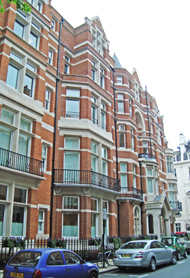
No. 78 Brook Street on the corner of Brook Street and Gilbert Street is now an office block.
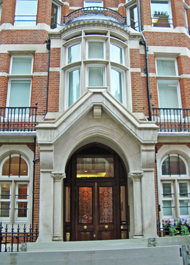
The main entrance is in Gilbert Street.
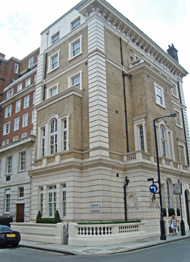
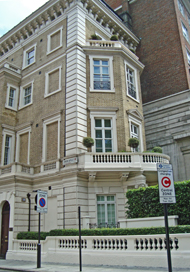
The former No. 24 Norfolk Street, now No. 128 Park Lane. The eastern elevation (left) is in Dunraven Street and the western in Park Lane (right), while the entrance (below) is in Green Street.
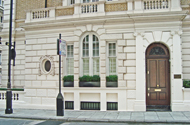
(Author unstated) 1917 Joint War Committee. British Journal of Nursing 10th February, 98.
(Author unstated) 1917 List of the Various Hospitals Treating Military Cases in the United Kingdom. London, H.M.S.O.
(Author unstated) 1917 Our work. The Red Cross 4, 136.
(Author unstated) 1921 Reports by the Joint War Committee and the Joint War Finance Committee of the British Red Cross Society and the Order of St John of Jerusalem in England on Voluntary Aid Rendered to the Sick and Wounded at Home and Abroad and to British Prisoners of War, 1914-1919. London, HMSO (reprinted in facsimile, 2009. The Naval and Military Press Ltd in association with the Imperial War Museum).
(Author unstated) 1925 The British Red Cross Society. County of London Branch Annual Reports 1914-1924. London, Harrison & Sons.
www.kentvad.org
Return to home page